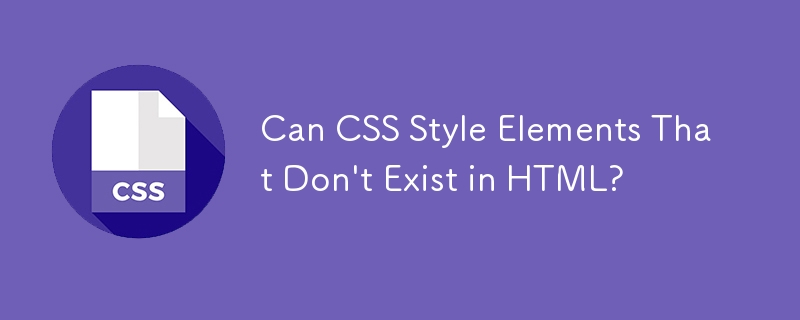Home >Web Front-end >CSS Tutorial >Can CSS Style Elements That Don't Exist in HTML?
Can CSS Style Elements That Don't Exist in HTML?
- Susan SarandonOriginal
- 2024-11-06 03:16:02913browse

CSS and Placeholder Elements: Delving into the Realm of Unconventional Markup
In the world of web development, it's often assumed that CSS can only style predefined HTML elements. However, as the questioner discovered, CSS has the remarkable ability to work with "made-up" or placeholder elements that do not exist in the HTML specification. This revelation raises important questions about the nature of CSS and its role in web rendering.
Why Does CSS Recognize Artificial Elements?
The reason lies in the forward-compatible nature of most browsers. They are designed to parse unrecognized elements into the Document Object Model (DOM), even though these elements have no default rendering or semantic meaning associated with them. This allows CSS, JavaScript, and ARIA to extend the functionality of these elements in older browsers, ensuring that content remains accessible and responsive across different platforms and devices.
The Case Against Placeholder Elements:
While placeholder elements can appear to work effectively, there are several reasons why their use is generally discouraged:
- Non-Compliance with HTML Standards: They violate the HTML specification, which does not include such elements. Using them could lead to inconsistencies in rendering or accessibility issues.
- Potential Conflicts with Future Standards: Placeholder elements may conflict with future additions to the HTML5 specification that introduce legitimate elements with the same name.
- Availability of Suitable HTML Elements: There are often existing HTML elements that can serve the same purpose as placeholder elements, ensuring compliance with standards and consistency across different web environments.
Uncommon Practice:
The use of placeholder elements is relatively uncommon among web developers. This is primarily due to the aforementioned drawbacks and the availability of better alternatives that adhere to web standards. Consequently, some developers may be unaware of the potential of CSS to work with these elements, leading to the professor's surprise in the example provided.
In conclusion, CSS's ability to style placeholder elements is a byproduct of browser compatibility and forward-looking design. However, their use is strongly discouraged as it violates HTML standards, introduces potential conflicts, and overlooks the benefits of using standardized markup that is widely supported and accessible.
The above is the detailed content of Can CSS Style Elements That Don't Exist in HTML?. For more information, please follow other related articles on the PHP Chinese website!

